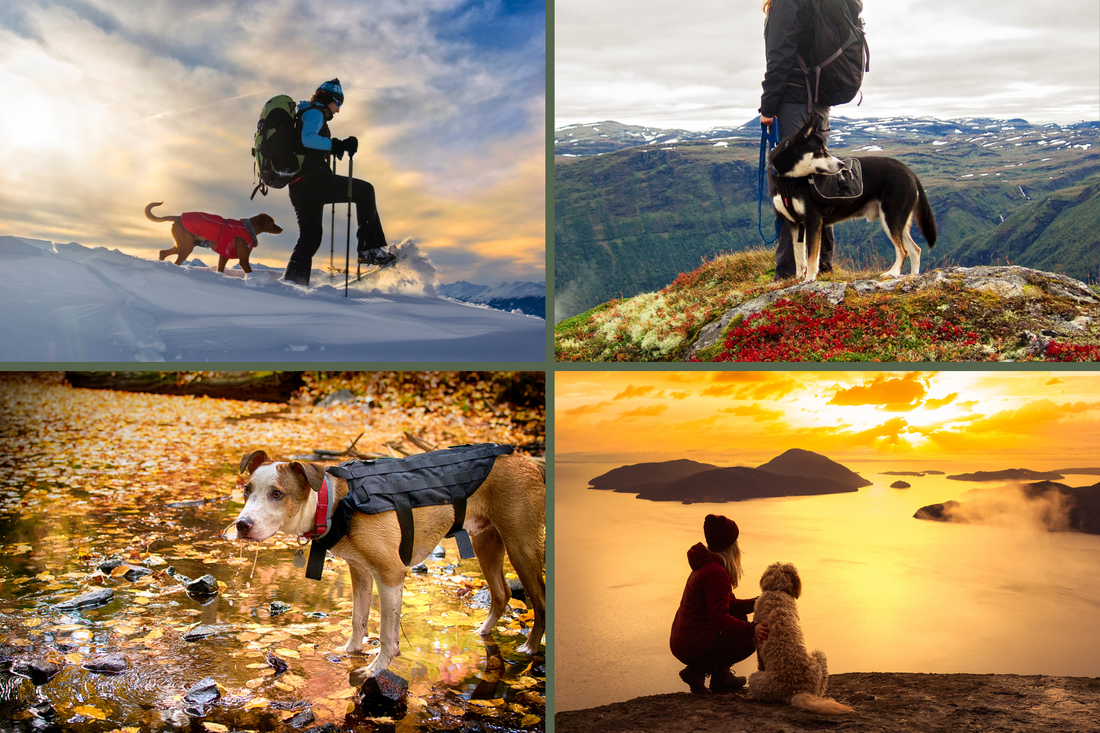
Seasonal Gear Guide: Outfitting Your Pet for Winter, Spring, Summer, and Fall Hikes
Share
Hiking with your pet is a year-round adventure, but each season comes with its own set of challenges. From freezing winter trails to hot summer paths, the right gear can make all the difference in keeping your pet safe and comfortable. This guide breaks down essential equipment for winter, spring, summer, and fall, so you’re always prepared.
Winter Hiking Gear: Keeping Your Pet Warm and Safe
Challenges:
- Cold temperatures can lead to frostbite and hypothermia.
- Snow and ice can cause paw irritation or injuries.
- Shorter daylight hours reduce visibility.
Essential Gear:
- Insulated Jacket or Sweater – Short-haired or small dogs benefit from extra warmth. A waterproof, fleece-lined coat keeps them dry and comfortable.
- Boots or Paw Wax – Ice, salt, and frostbite are common hazards. Insulated boots provide protection, while paw wax helps prevent cracking.
- Reflective Gear and LED Collar – With less daylight, a reflective harness or LED collar makes your pet more visible.
- Portable Water Bottle – Dehydration is still a risk in cold weather, and an insulated water bottle prevents freezing.
- Moisturizing Balm – Cold air can dry out paw pads and noses, leading to cracks and discomfort.
Tip: Avoid letting your dog eat snow—it may contain harmful bacteria, deicers, or antifreeze.
Spring Hiking Gear: Navigating Mud, Rain, and New Growth
Challenges:
- Mud and rain can make hikes messy and uncomfortable.
- Ticks and fleas become more active.
- Allergens like pollen and mold may cause irritation.
Essential Gear:
- Waterproof Raincoat – A lightweight, breathable raincoat keeps your pet dry and clean.
- Tick & Flea Prevention – Spring is peak tick season. Use a vet-approved preventative and carry a tick removal tool.
- Fast-Drying Towel and Wipes – Keep a packable towel and pet wipes handy to clean muddy paws before getting back in the car.
- Lightweight Harness and Leash – As temperatures rise, a breathable harness prevents overheating.
- Boots for Muddy Trails – If your dog dislikes wet paws, waterproof boots add comfort and protection.
Tip: Always check your dog’s paws for ticks, burrs, and debris after a hike.
Summer Hiking Gear: Beating the Heat
Challenges:
- High temperatures increase the risk of heat exhaustion.
- Hot pavement and rocky trails can burn paws.
- Dehydration is a major concern.
Essential Gear:
- Cooling Vest or Bandana – Soaking a cooling vest or bandana in water helps regulate body temperature.
- Protective Dog Boots – Hot pavement and sand can cause burns. Ventilated boots provide a protective barrier.
- Collapsible Water Bowl and Extra Water – Hydration is key, and a foldable bowl makes it easy to keep your pet drinking.
- Dog Sunscreen – Short-haired and light-colored dogs can get sunburned. Use a pet-safe sunscreen on exposed areas.
- Bug Repellent for Pets – Mosquitoes and ticks are common in summer. A natural or vet-approved spray helps keep them away.
- Emergency Cooling Mat – For longer hikes, a portable cooling mat can help lower body temperature during breaks.
Tip: Plan hikes for early morning or late evening to avoid peak heat hours (10 AM - 4 PM).
Fall Hiking Gear: Preparing for Cooler Days and Leafy Trails
Challenges:
- Cooler temperatures mean pets may need extra layers.
- Wet leaves and hidden hazards can make trails slippery.
- Wildlife activity increases as animals prepare for winter.
Essential Gear:
- Lightweight Insulated Jacket – Early fall hikes may not require full winter gear, but a thin insulated jacket keeps your pet warm on chilly mornings.
- Reflective Gear for Shorter Days – A reflective leash, collar, or harness improves visibility as daylight hours decrease.
- Paw Protection – Damp, decaying leaves can carry bacteria and fungi. Boots or paw-cleaning wipes help prevent infections.
- Whistle or Voice Alerts – Rather than relying on bear bells, which have mixed effectiveness, talking, clapping, or using a whistle can be a more reliable way to alert wildlife to your presence.
- Bear Spray (if in bear country) – If you’re hiking in areas with bears, carrying bear spray and knowing how to use it is essential for safety.
Tip: Keep an eye out for fallen acorns, mushrooms, and moldy leaves, as they can be toxic if ingested.
Final Thoughts: Ready for Any Season
Each season presents unique hiking conditions, but with the right gear, your pet can enjoy the outdoors safely year-round. Investing in seasonal essentials ensures they stay comfortable, whether facing icy trails, muddy paths, summer heat, or crisp autumn air.
Share your favorite hiking season in the comments—what time of year does your pet love the most?
